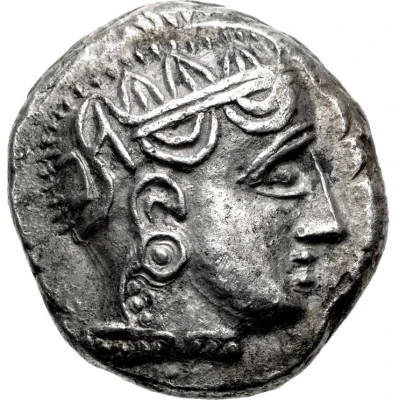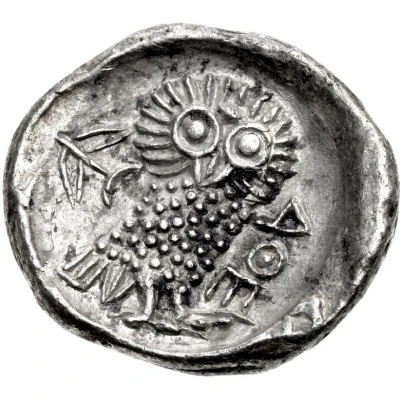


© Classical Numismatic Group, Inc.
Tetradrachm 250 BC - 150 BC
| Silver | 17.08 g | 24 mm |
| Issuer | Minaean Kingdom (Southern Arabia) |
|---|---|
| Type | Standard circulation coin |
| Years | 250 BC - 150 BC |
| Value | Tetradrachm (4) |
| Currency | Drachm (ca. 300 – 25 BC) |
| Composition | Silver |
| Weight | 17.08 g |
| Diameter | 24 mm |
| Shape | Round (irregular) |
| Technique | Hammered |
| Orientation | Variable alignment ↺ |
| Demonetized | Yes |
| Updated | 2024-10-09 |
| Numista | N#221553 |
|---|---|
| Rarity index | 94% |
Reverse
Owl standing right, head facing; 'fused' olive spray and crescent to left, AΘE to right; all within circular incuse.
Script: Greek
Lettering: AΘE
Comment
Cf. Huth 152 (for similar).As can be seen from the style of both its images and inscription, as well as from the strangely 'fused' olive-spray and crescent, this coin clearly belongs to the same series as the curious 'folded flan' tetradrachms (CCK 152 ff.). These coins were probably minted in the Minaean kingdom (composed of several city-states) that was situated in the area of Wadi Al-Jawf northeast of Sana'a, and bordering the Sabaean kingdom to the south. As discussed by M. Huth ("Monetary Circulation" in CCK, pp. 86ff.), the folded-flan coins were probably produced by hammering imported coins (in all likeliness, Athenian tetradrachms) into a flat round that was subsequently folded once or twice, and then struck. Obviously, overstriking imported coins would have been a much easier way of producing new coins from existing ones, and one has to ask why the Minaeans chose such a cumbersome method of production. The present coin, however, proves that overstriking was indeed used concurrently with the folding technique. As a consequence, the folded flan technique becomes even more enigmatic. It would be most interesting to identify the undertype of the present coin. (source: Classical Numismatic Group, Auction 99 catalog, lot 376)
Interesting fact
One interesting fact about the Minaean Kingdom Tetradrachm is that it features a unique blend of Greek and Arabian design elements. The coin's obverse (front) side features a portrait of a king wearing a traditional Arabian headscarf, while the reverse (back) side depicts a Greek-style mythological scene, such as a griffin or a sphinx. This fusion of design styles reflects the cultural exchange and influence that occurred between the ancient Greek and Arabian civilizations in the region.